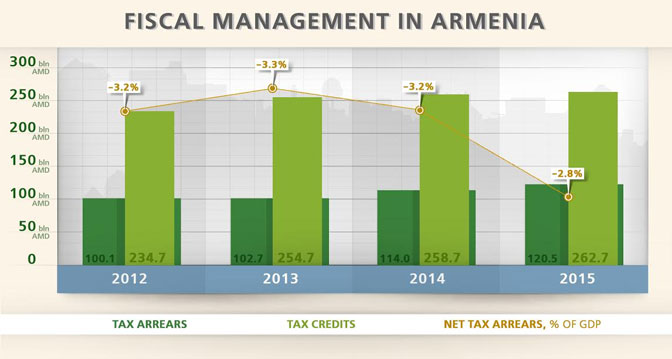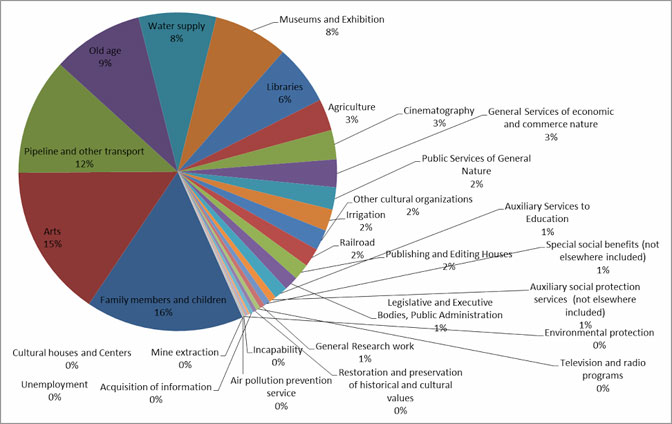
Armenia: Businesses Are Subsidizing the State Budget: Tax Credits Exceeded 260 Billion Drams by the End of 2015
Gohar Gyulumyan, Senior Economist at the World Bank, answers Hetq questions.
The World Bank (WB) recently released a new study on Armenia's public financesby the teamyou led. According to it, taxpayers have subsidized the state budget in past years. Excess tax payments collected exceeded 10 percent of annual tax revenues. Had no tax credits been collected from taxpayers, would Armenia's budget deficit have been larger?
Yes, at the end of 2015 tax credits exceeded 260 billion drams. Had the government taken loans or issued treasury bonds equivalent to such amount, not only would such borrowings have to be repaid according to the established schedule, but also interest equivalent to US$ 56-60 million per annum (10-12 percent on average per year) would have to be paid from the state budget. However,based on the scarce information available ontax credits between 2012 and 2015, it can only be stated that the stock hasincreased by almost 30 billion drams. It is nowbeing stated that the practice of collecting advance tax payments has been stopped. However, as of the end 2016,respective data have not been released yet to make comparisons and conclusions. Time and dynamics in numbers will show whether the practice of collecting excess tax payments has lessened or not.
Atax credit arises when a taxpayer pays an additional tax on top of current tax liabilities, which could include the amounts of VAT credits not refunded in case of exports,as well as advance payments driven by a desire toaccommodate the addresses of the tax authority with an expectation that they would be offset against future tax liabilities. In Armenia, tax arrears are also significant and amounted to 120 billion drams at the end of 2015. I think that tax credits and tax arrears are distributed asymmetrically. It is known that 10-15 years ago,large taxpayers contributed more than 70 % of the state budget revenue, and it used to be an objectivereflection of the realities in the economy. It meant that the role of large taxpayers in the economy was commensurate with their role in tax collections. Payments by large taxpayers have fallen to 52-53% in recent years. The government talks about improvements in collections from large taxpayers in the last months of 2016 resulting in perhaps up to 55 % share; however, it is still a distorted picture. At least 70-80 % of the tax revenue should be generated from the taxes paid by large businesses.

So, are tax collection targets mainly achieved from small and medium-sized businesses?
The numbers above show that more than half of the tax revenue in the budget is still contributed by large businesses. However, the contribution of SMEs is not proportionate to their role in economic activity. It should be noted, that from the tax policy perspective, the situation in Armenia has been unclear after increasing the VAT threshold abruptly from 58 million drams to 115 million drams as a certain number of large taxpayers fell under a softer tax regime intended for the SMEs which led to erosion of the tax base and also created un-level playing field for real SMEs. Considering also the latter’s “contribution” to tax credits, SME’s end up having a higher tax burden.
What would be the projection for the state budget if taxpayers greatly complain aboutsuch a policy and,at some point might decide to protect their rights and stop to pay taxes until advance payments are repaid?
The Tax Code, which comes into effect in 2018, has already provided for a legislative solution to this issue, and hopefully by that date the government would also establish the technical and administrative procedures for automatically offsetting debits and credits of taxpayers. However, this is still not the case. Sadly, there is no plan or concept note for reducing the stock of tax credits and tax arrears. Under the current economic situation, the government should form an approach to this critical issue for the business climate. External challenges are having an increasingly adverse impact on Armenia’s economy. During 2010-2013,Armenia’seconomy grew by 4.3 % on average, while in 2014-2016 it fell to 2.3 %. Obviously, the excess tax payments of 260 billion drams noted above, which account for 20 % of annual state budget revenue, would not be possible to refund to taxpayers within one year. No matter how difficult the problem is, the current government has inherited it from its predecessors and could take an approach to it. For instance, one option would be to offset tax credits within 5 years, based on specific criteria and schedule.
Several economic sectors, such as energy, transport, water, agriculture, irrigation, railways, etc., are subsidized from the state budget. Have researchers assessed if these subsidies are effective and targeted, and whether it is appropriate to continue them?
Including the subsidies in the public expenditure review pursued the objective of also identifying how effective and targeted was the financing of these sectors through subsidies. The current fiscal situation is very complicated, and reducing public expenditure could have negative implications for the already low economic activity and social situation, under the same efficiency indicators. However, the unsustainable fiscal deficit in 2015-2016 makes it imperative to enhance revenue mobilizationon the one hand, and to reduce inefficient expenditure, on the other. One of the findings of our review is that it is possible to improve the efficiency of spending programs. If a sector is subsidized from the state budget, the government should introduce performance indicators and estimate what outcome it wants to get against the subsidy provided. Under budget subsidies in many sectors there is no clear link between the spending and expected outcome. The system of monitoring subsidies should be institutionalized.

Some sectors, such as energy and irrigation, where significant loans were invested in past years, are projected to become self-financingafter some time. However, no sector is seen as having overcome the dependence from the subsidy. Can this be only attributed to poor administration in these sectors?
Apparently, the structural credits provided by the WB since the end of 1990, have periodically addressed the self-financing issues in the sectors you mentioned. Previously, governments prepared schedules several times, as to howthe irrigation tariff policy should change by years to allow the system to achieve cost-recovery. The strategy for this sector has been periodically reviewed, with the most recent revision happening last year. There are many crosscutting issues, not just administration. The tariff policy is impacted by the quality of administration in the sector, financial discipline, accountability and supervisory mechanisms. Tariff policy in Armenia, not only in irrigation but also for other public services, is highly sensitive to political developments.
Undoubtedly, it is not desirable and sustainable to achieve cost recovery by only relying on the tariff policy if there are structural issues in the sector, such as in the energy sector. Key reforms took place between 1998 and 2005, resulting in a situation where the sector was self-reproduced without creating any major tariff policy or governance issues. However, since 2010, due to certain changes in the governance area of the sector, the financial performance of the system deteriorated and resulted in major problems. Just by increasing the tariff and including all types of expenses in the tariff and forcing the consumer to solve all those problems is not the right approach. It should be examined how such financial flows have been generated, ultimately leading to accumulation of arrears in the sector and later assess how justified is their incorporation into the tariff calculations.
If a specific sector still requires time to achieve self-cost recovery, even in such case, only specific expenses can be targeted - for instance, only subsidizing capital spending for the sector from the budget. Poor administration is part of the problem, but it is not less important today. There are sectors, for instance, the water users’ associations in irrigation, the financial statements of which are not audited,raisingquestions as to their trustworthiness. As a result, despite 5-6 billion drams in annual budget subsidies provided, 5-6 billion drams of arrears have been accumulated in the sector, only a part of which could be explained by increased energy tariffs from previous years. Here also an approach must be taken to prevent further accumulation of arrears and clean the stock of inherited arrears within a specific timeframe.
It has been always emphasized that agriculture is even subsidized in developing countries. The government of Armenia provides several types of subsidies to the agricultural sector, such as irrigation, diesel fuel, seeds, participates in providing concessional loans to farmers, etc. Farmers’ losses from disasters or unfavorable weather conditions are also covered. Do you think it would be possible to stop subsidizing any of the sectors listed above, and in which case?
It is true that agriculture is subsidized even in developed countries. The question is what programs are subsidized by the government, how, what are the objectives set, and how does the subsidy contribute to improving the target indicators. We have discussed the report with the Ministry of Agriculture and we already see their first policy change responses. A decision was made on replacing the diesel fuel and seed subsidy with the leasing scheme for agricultural equipment, to purchase tractors and other machinery and grant to farmers for use.
There are a few issues associated with the subsidy. In the study we tried to examine whether they are pro-poor or targeted, and how appropriate was the chosen mechanism of providing the subsidy. It turned out that the fertilizer market is non-competitive, and the prices are high because of one or two importers. Therefore, a fertilizer produced in Georgia was imported into France at a lower price than it reached Armenia from Georgia. What issue is addressed by subsidizing fertilizers from the state budget? If this program is replaced with farm machinery leasing,criteria stillmust be introduced, includingwho the subsidy should be provided to and against what results. The issue is not just replacing one inefficient program with another. There should be assurancesthat state resources are spent efficiently.
Armenia’s external debt is growing steadily, and recently there are more warnings that it has hit the ceiling. However, a few days ago,the Minister of Finance announced taking new loans given the budget deficit. Definitely, in some sectors, the state will have to take additional loans, such as for maintaining the water and power sector infrastructure, asphalt pavement, etc. What is this driven by and what awaits Armeniaif the debt burden continues to increase?
Public debt is a concept thatis not judged by being above or below the line, but rather by the country’s capacity to service it. In any case, Armenia’s legislation introduced an adjusting rule - when the public debt-to-gross domestic product (GDP) ratio exceeds 50 percent, the government must not exceed 3 % of the average GDP for the last 3 years when planning the state budget deficit for the coming year. The 2017 budget was submitted to the parliament and approved in line with this rule.
According to the government’s projection, the public debt at the end of 2016 would have been higher than 50% of the GDP. Thus, the government has already planned a contractionary fiscal policy to more sustainably manage the fiscal deficit. With deficit at 4.6 % in 2015, it was planned to start fiscal consolidation in 2016 which would narrow the deficit to 3.5 % of GDP. However, due to the overall macroeconomic situation in 2016, this was not possible, due to low growth, deflation, reduced prices and volume of imports, the expansionary fiscal policy eventually continued to stimulate domestic demand resulting in a higher-than-anticipated deficit, and thus, more debt was taken.
I think this is not a matter of interpretation. The line established by Armenian legislation has been hit and exceeded, and the government has taken adjusting actions to be able to manage the budget deficit at a more sustainable level. A deficit of 2.7% of GDP planned for 2017 also requires financing, and would thus lead to a further increase in the debt burden. At the end of 2017, the debt-to-GDP ratio is expected to grow from 55 % to 57%. However, the number per se does not mean anything. The debt burden, in fact, depends on what is the country’s capacity to service the debt. For instance, Japan’s debt is 200 % of GDP, but it has not occurred to anyone that Japan is facing a potential default or debt problem. Japan has a big economy and large exports, andtherefore debt service is not a problem for it.Armenia’s case is different.
Between 2014 and 2016, external debt service which includes interest payments and amortization (loan principal repayment) together, grew cumulatively by 3.7 times, while the country’s exports grew only by 2.3 times. Exports are the country’s ability to earn foreign exchange. If sufficient foreign currency is not generated relative to the increase in external debt,the latteris then serviced at the expense of accumulated reserves, which leads to depreciation in the country’s currency. Between 2014 and 2016, Armenia’s economy expanded only by 7.3%, while public debt increased by 30 % over the same period. If the country’s public debt grows at a higher pace compared to its economic growth, it is a warning of anunsustainable debt taking policy.
Armenia’s legislation establishes two thresholdsfor public debt, after 50 % of GDP, the norm which I mentioned, is triggered, while after 60 % of GDP it is prohibited to incur new debt. Under current circumstances the 60 percent of GDP threshold has not been exceeded, however, it would be preferable to plan the fiscal policy in such a manner as to not only the ceiling would not be exceeded but also reserves could be generated for a “rainy day”.
Sectoral assessments suggest that all sectors in Armenia are underfunded from the budget. The road network, despite current funding amounts, receives significantly less resources compared to its funding demand. The same is true of the social sectors: education, health, social protection, etc. Public finance is at critical level, and they cannot be further decreased without deteriorating the infrastructure of those systems. In Europe and Central Asia, Armenia is only ahead of Tajikistan in terms of the level of sectoral allocations made from the budget.
As mentioned in the report, private spending in Armenia has a very important role for the education and health sectors. Although fiscal space in the state budget is limited from macro perspective, reduced public spending could be fraught with undesirable consequences; in such a situation, innovative, non-public debt creating funding arrangements should be introduced. One of the possible options is the private-public partnership by clarifying the scope of roles and responsibilities of both private investors and respective government agencies. However, partnership does not occur by merely announcing about it. It works when the country creates an adequate legislative framework and develops professional regulatory institutions to build trust among investors.
 Videos
Videos Photos
Photos
Comments (1)
Write a comment